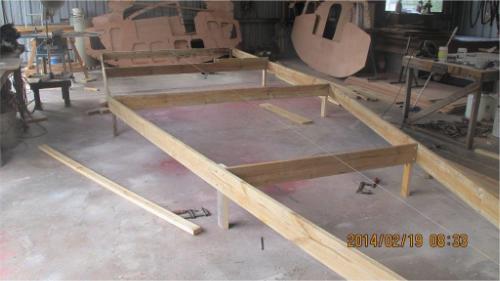|

|
Our thanks to Fred Grimminck in Australia and Mike Vermeersch in Ohio USA for supplying these build photos of their projects. Fred is building from scratch and Mike is building from a kit that we supplied. Click for info on the kits
Layout of the building stocks.
|
|

|
Transom doubler set up on building stocks.
|
|

|
Bulkheads being set up vertical and level.
|
|

|
All bulkheads set up and braced. The plywood backbone has also been installed.
|
|

|
Same stage, viewed from aft. The backbone is tabbed into the transom doubler, seen as the dark rectangles on centreline of the doubler. The backbone is notched eggcrate fashion into the bulkheads to locate them accurately and securely.
|
|

|
All stringers installed. The two wide stringers on each side are the tangent stringers where the flat and radiused panels connect. A plywood doubler provides the gluing area over which the junction is made.
|
|

|
Same stage, looking from aft. The backbone is on centreline in the bow and stern but changes to a pair of backbones or girders, offset from centreline, in the middle of the boat. The steel support box for the keel and engine will be mounted between the two girders and supported by them.
|
|

|
The stringers and backbone are notched through the transom doubler and will be covered by the transom when that is fitted.
|
|

|
The backbone components before installation into the structure. At top left is the aft backbone, which turns up to support the transom. At lower right is the forward backbone, which turns up to form the stem. The other two parts are the double backbone that hold the keel support box.
|
Back to Didi 950 Notes
Back to Didi 950
|
Back to Didi 950 Notes
Back to Didi 950
|